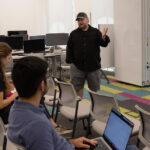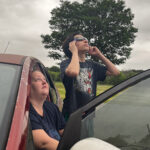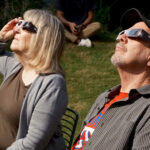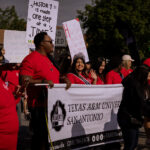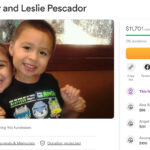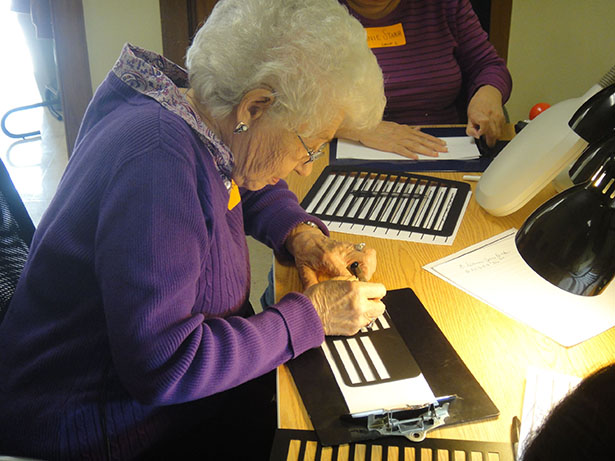
By Gladys Nuñez
For Eleanor Baker, everyday tasks such as cooking and cleaning are a challenge. But twice a year, when the Seniors Program at the San Antonio Lighthouse for the Blind (SALB) visits her home, those routine tasks are made easier.
Baker, 83, has macular degeneration which caused her to lose total vision in her left eye. She has 10 percent vision in her right eye.
Last week, the staff helped her with the everyday task of threading a needle during their visit.
“They gave me a needle threader and I can’t get it to work,” said the Center Point resident. “I am so blind I can’t hardly use it but I want them to train me with it.”
“Whenever I had found out I had macular degeneration, they (the doctors) said the best thing I could do is to go to the Lighthouse for the Blind in San Antonio on Roosevelt Road and so I contacted them and that was in 1996,” Baker explained.
The city’s South Side private nonprofit offers rehabilitation services for the visually impaired in the city including career guidance, adaptive hardware and software, job readiness and placement, technology evaluation and training, as well as other services.
Doctors and referrals are often the key to helping the blind and visually impaired find the resources they need.
For a senior to receive assistance from the program, they can call the Seniors Program or get referred by doctors, eye clinics, home health agencies and social workers.
The Seniors Program, a one-of-a-kind program in Texas, serves those over 50 who have a visual impairment. Seniors program manager Sha Moore said the program has provided services to over 3,300 seniors in the fiscal year of April 2013 to March 2014.
Seniors do not pay to receive services. The program caters to low income seniors.
“We focus on people who are low income but we don’t turn people away,” Moore said. “It will just mean if they’re over our income guideline we would have some limitations on the amount of each service we can provide.”
Baker lives by herself after her husband passed away in April of 2005.
“I don’t drive, but I have church people that pick me up to go to church and to the grocery store,” Baker said.
She goes 10 miles to buy groceries in Kerrville and 30 miles to see her doctors in Fredericksburg.
Baker went to the SALB for a training session that lasted four days in November of last year. The seniors learned how to clean a bathroom, fix food while blindfolded and use a white cane.
“There we learned how to go up the stairs and down the stairs and then we all ate together,” Baker said. “There were six of us in the session and there were three that were completely blind and it was marvelous to be around them.”
Seniors Program provides training in the home, white cane training, counseling services, low vision clinic evaluations, and help with payment for any devices the seniors might need.
The program goes to senior homes within a 75-mile radius from the lighthouse. Moore has gone to senior homes in Jourdanton, Pleasanton, Fredericksburg and Kerrville.
“Since we’re grant funded, we sometimes get grants that require us to focus our services in specific areas,” Moore said. “Right now we have a grant that will have us providing services in New Braunfels and Comal County.”
Baker said the program assisted with cooking and cleaning. When she needs to clean the floor, Baker uses a mop that sprays water, making it one-step easier for her to keep the house clean. She has a presser that helps her eliminate wrinkles and white lint from her clothes.
She has also received white cane training.
“I’ve had the habit of finding rough places on the sidewalk and where you park your car and that white thing you roll back up to,” Baker said. “I am scared I’m going to fall on it but yet when you’ve got that white cane, it finds it for you.”
Moore said the program continuously evolves, including a new sensory studio.
The studio is a simulated apartment where seniors receive training for daily living activities that may be difficult because of vision loss.
“This will be an avenue for people to come here because sometimes it’s hard to think of ways to do things outside of what you’re used to,” Moore said. “We’re always trying to find ways to better get in touch with the senior community and we’re always open for suggestions.”
Baker feels that people should know about the program.
“I think it would be beneficial for other people to see what this program is about,” Baker said. “I think that everybody should go at least one time to see what goes on.”
SALB offers other rehabilitation services, including The Blind Children’s Education Program.
Children’s program coordinator Rachel Rosenfield said the Blind Children’s Education Program started January 2014.
“I think [the program] came about because we are an entity that serves people with visual impairments and we didn’t have a program for children and they decided to start one because they saw a need in the community,” Rosenfield said.
Only legally blind children qualify for the rehabilitating and empowering program from birth through age 14.
“To help them in school, to help socially, to help them when they get older like jobs and transition into being an adult and to be able to function in our society and in our world,” Rosenfield said.
The children in the program receive technology instruction, Braille instruction, self help skills, orientation and mobility training, and physical education classes.
“We’re basically teaching them all the things that you would teach any normal kid but most kids who are normally developing, they don’t need to be taught certain things,” Rosenfield said.
Rosenfield recalls how the program gave a magnifier to a four-year-old suffering from vision-loss.
“She was trained on how to use the magnifier and that’s really helped her…in learning to be able to read which is obviously something everyone needs to know.”
[divide]
Photographer’s Journal
By Blanca Z. Garcia
In life, there are so many things that we take for granted. Having the ability to see is one of them. Members at the Lighthouse for the Blind suffer from many eye diseases, some of the most common are glaucoma, diabetic retinopathy, and cataracts.
When my team assigned me to photograph the location, I had no idea what to expect. I arrived to the center at 7:30a.m. with my usual cup of coffee and camera in hand. Nancy Lipton, who is in charge of public relations, gave me a tour throughout the building like we had planned the day before. We went first to the biggest room filled with sewing machines and machine operators working on the army chin straps. At first, I didn’t know how to approach the members so I just did my job and took some pictures. I looked into my camera to check the photos and none of them looked like they had any potential to make it for the website. We then went into the last room where they assembled the pens. There, I found what impacted me the most. Two of the members sitting at the very last table in the corner were the perfect subject to photograph. Josuah Saud had a brain tumor and Jeffrey Olivarez received a gunshot in the head, which led to complete blindness. I didn’t know how to approach them or how to tell them that I wanted to take a picture of them, but I still did it. Saud very nicely agreed when I had introduce myself as a photographer for The Mesquite and shook my hand. Olivarez also agreed but this time I put my hand to shake his hand, forgetting that he couldn’t see me. Lipton placed my hand on his hand so he could feel it and greet me. I told them to keep working normally, their ability to move fast and to know where all the material was placed really surprised me.
The tour lasted no more than 30 minutes. It was in that little time that I learned that members who are part of this program had learned how to use their other senses and thus be able to work like anyone else would do it; and for my own learning, I learned how to appreciate something as simple as sight.


